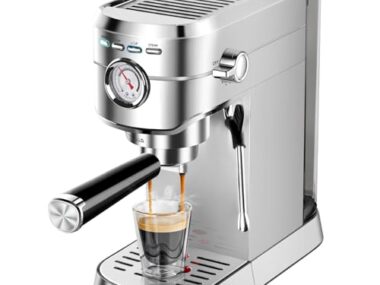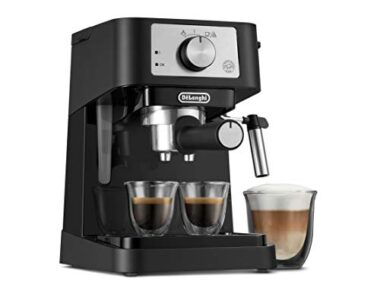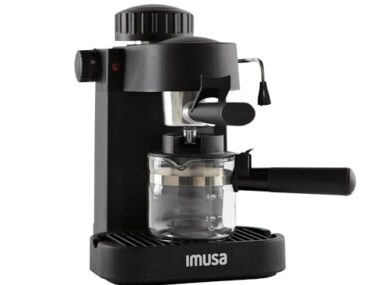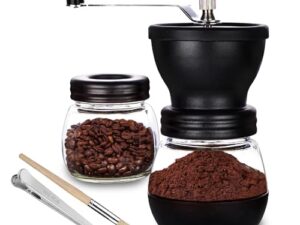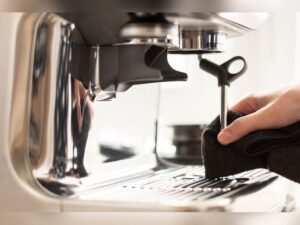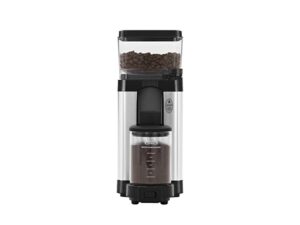If you love the rich, bold taste of coffee and the creamy texture of perfectly steamed milk, making a cappuccino at home might be your next favorite skill. Imagine waking up to a café-quality cappuccino without leaving your kitchen.
You might think it’s complicated, but with your espresso machine and a few simple steps, you can create a delicious cappuccino that rivals any coffee shop. In this guide, you’ll learn exactly how to make a cappuccino with an espresso machine step by step, ensuring each cup has the perfect balance of espresso, steamed milk, and frothy foam.
Ready to impress yourself and anyone you share your coffee with? Let’s dive in and turn your coffee routine into an enjoyable ritual.

Credit: www.sharkninja.com
Essentials For Cappuccino
Making a great cappuccino starts with the right essentials. Each part affects the taste and texture. The espresso machine, coffee beans, and milk all play key roles. Knowing what to choose helps you craft a perfect cup every time.
Below are the main essentials to focus on before you begin making your cappuccino.
Choosing The Right Espresso Machine
Select an espresso machine that fits your needs and budget. Machines with a steam wand allow you to froth milk easily. Look for models with good pressure, usually 9 bars, for rich espresso. Compact machines are great for small kitchens. Machines with built-in grinders save time and space.
Selecting Coffee Beans
Choose fresh, high-quality coffee beans for the best flavor. Medium roast beans balance acidity and bitterness well. Whole beans keep flavor longer than pre-ground coffee. Grind beans just before brewing for maximum freshness. Arabica beans offer smooth taste; Robusta adds strength and crema.
Milk Types And Their Impact
Milk texture changes the cappuccino’s body and taste. Whole milk creates creamy, rich foam. Low-fat milk produces lighter foam with less creaminess. Plant-based milks like oat or almond vary in frothing ability. Use cold milk for better froth. Fresh milk steams to a smooth, velvety texture.
Preparing The Espresso
Preparing the espresso is the first step to a great cappuccino. It sets the base for the rich and creamy drink. Focus on grinding, tamping, and pulling the shot carefully. Each step affects the flavor and texture of your coffee. Follow these simple instructions for the best results.
Grinding Coffee Beans
Use fresh coffee beans for the best taste. Grind them just before brewing. Set your grinder to a fine setting, similar to table salt. Avoid too coarse or too powdery grounds. The right grind ensures proper extraction and rich flavor.
Tamping For Even Extraction
After grinding, place the coffee into the portafilter. Use a tamper to press the grounds evenly. Apply firm and consistent pressure, about 30 pounds. A level tamp helps water flow evenly through the coffee. This prevents bitter or weak espresso shots.
Pulling The Perfect Shot
Lock the portafilter into the espresso machine. Start the extraction immediately to avoid burning the coffee. Aim for a 25-30 second shot time. The espresso should flow like warm honey. Stop the shot once it turns pale and thin for best taste.
Steaming And Frothing Milk
Steaming and frothing milk is a key step in making a delicious cappuccino. It gives the drink its creamy texture and rich flavor. The right milk texture balances well with the strong espresso. This section explains how to steam and froth milk perfectly using your espresso machine.
Choosing The Right Milk Temperature
Start by choosing the correct milk temperature. Aim for 140°F to 150°F (60°C to 65°C). Milk heated above this can taste burnt. Cold milk froths better, so use fresh, chilled milk. Avoid overheating to keep milk’s natural sweetness.
Creating Silky Microfoam
Microfoam is smooth and glossy, not bubbly or dry. To create it, position the steam wand just below the milk surface. Introduce air slowly by lowering the pitcher slightly. Move the wand deeper to heat milk evenly. The result is creamy, velvety foam that blends well with espresso.
Using The Steam Wand Correctly
Clean the steam wand before starting. Submerge it just below the milk’s surface. Turn on the steam and listen for a gentle hissing sound. Avoid large bubbles; keep a steady position. Tilt the pitcher slightly to create a whirlpool effect. This mixes air and milk for perfect texture. Turn off steam before removing the wand to avoid splashing.
Combining Espresso And Milk
Combining espresso and milk is the heart of making a great cappuccino. This step blends the rich, bold espresso with creamy, textured milk. The goal is a smooth, balanced drink with perfect flavor and feel. Proper technique makes the difference between a simple coffee and a café-quality cappuccino.
Pouring Techniques For Texture
Start by holding the cup at an angle. Pour the steamed milk slowly into the espresso. Use a steady, controlled pour to mix milk and coffee evenly. Keep the milk pitcher close to the cup. This helps create a velvety texture. Avoid pouring too fast or too high to keep the foam thick.
Achieving The Classic Cappuccino Layer
A good cappuccino has three layers: espresso, steamed milk, and foam. Pour the milk until the cup is nearly full. Then add the foam on top with a gentle scoop. The foam should be thick and creamy, about one-third of the drink. This layer adds a light, airy feel with every sip.
Tips For Latte Art
Latte art starts with smooth, well-textured milk. Begin pouring in the center of the cup. Move the pitcher gently side to side to create designs. Finish by lifting the pitcher to draw shapes like hearts or leaves. Practice helps improve control and creativity. Simple patterns make the cappuccino look inviting and special.
Common Mistakes To Avoid
Making a cappuccino with an espresso machine is simple. Yet, some mistakes can spoil your coffee experience. Avoid these common errors to enjoy a smooth, creamy cappuccino. Below are the most frequent mistakes to watch out for.
Overheating Milk
Milk should be steamed to about 150°F (65°C). Overheating milk burns it and changes the taste. It also kills the natural sweetness. Use a thermometer or feel the pitcher’s side. Stop steaming as soon as it feels hot but not too hot.
Under Or Over Extracted Espresso
Extracting espresso too quickly or too slowly affects flavor. Under-extraction tastes sour and weak. Over-extraction tastes bitter and harsh. Aim for a 25-30 second extraction time. Use the right grind size and tamp pressure for balanced espresso.
Improper Frothing Methods
Frothing milk wrongly leads to large bubbles and poor texture. Position the steam wand just below the surface. Move the pitcher gently to create smooth microfoam. Avoid mixing air and milk too much. Good froth is creamy and silky, not bubbly.

Credit: www.reddit.com
Cleaning And Maintenance
Keeping your espresso machine clean is key to making great cappuccinos every time. Regular cleaning stops milk residue and coffee oils from building up. This helps your machine work well and keeps your coffee tasting fresh. Proper maintenance also prevents breakdowns and costly repairs. Spend a little time each day and week caring for your machine. Your cappuccinos will taste better, and your machine will last longer.
Cleaning The Steam Wand
After each use, wipe the steam wand with a damp cloth. This removes milk residue before it hardens. Purge the wand by turning on steam for a few seconds. This clears milk inside the wand. Once a week, soak the steam wand in warm water with a little detergent. Use a small brush to clean inside the nozzle. This keeps the steam flow strong and milk fresh.
Regular Machine Maintenance
Empty the drip tray and coffee grounds container daily. Clean the portafilter and group head with a brush every few days. Run a cleaning cycle with a machine-specific cleaner once a month. Descale your machine regularly to remove mineral buildup. Follow the manufacturer’s instructions for descaling. This protects the heating element and keeps water flow steady.
Extending Machine Life
Use filtered water to reduce scale buildup. Avoid using harsh chemicals or abrasive tools on your machine. Keep the machine in a dry, cool place when not in use. Check seals and gaskets for wear and replace them if needed. Regularly inspect all parts and clean them carefully. Proper care helps your espresso machine last for years.
Customizing Your Cappuccino
Customizing your cappuccino lets you enjoy a unique coffee experience at home. Small changes can make a big difference in taste and texture. Experimenting with flavors, milk choices, and ratios helps you find your perfect cup. This section guides you through simple ways to personalize your cappuccino easily.
Adding Flavors And Sweeteners
Enhance your cappuccino with syrups like vanilla, caramel, or hazelnut. Use small amounts to avoid overpowering the coffee. Natural sweeteners such as honey or maple syrup add gentle sweetness. Sprinkle cinnamon or cocoa powder on top for extra aroma and taste. These additions create a richer and more enjoyable drink.
Adjusting Milk To Coffee Ratio
The classic cappuccino uses equal parts espresso, steamed milk, and foam. You can increase milk for a creamier, milder cup. Use less milk if you prefer a stronger coffee flavor. Adjust foam thickness based on your texture preference. Finding the right balance creates a cappuccino that suits your taste.
Alternative Milk Options
Try almond, oat, soy, or coconut milk to change flavor and texture. Each milk type froths differently, affecting the foam quality. Almond milk offers a nutty note, while oat milk is creamy and smooth. Soy milk provides a rich texture close to dairy. Choose the milk that fits your diet and flavor preference.
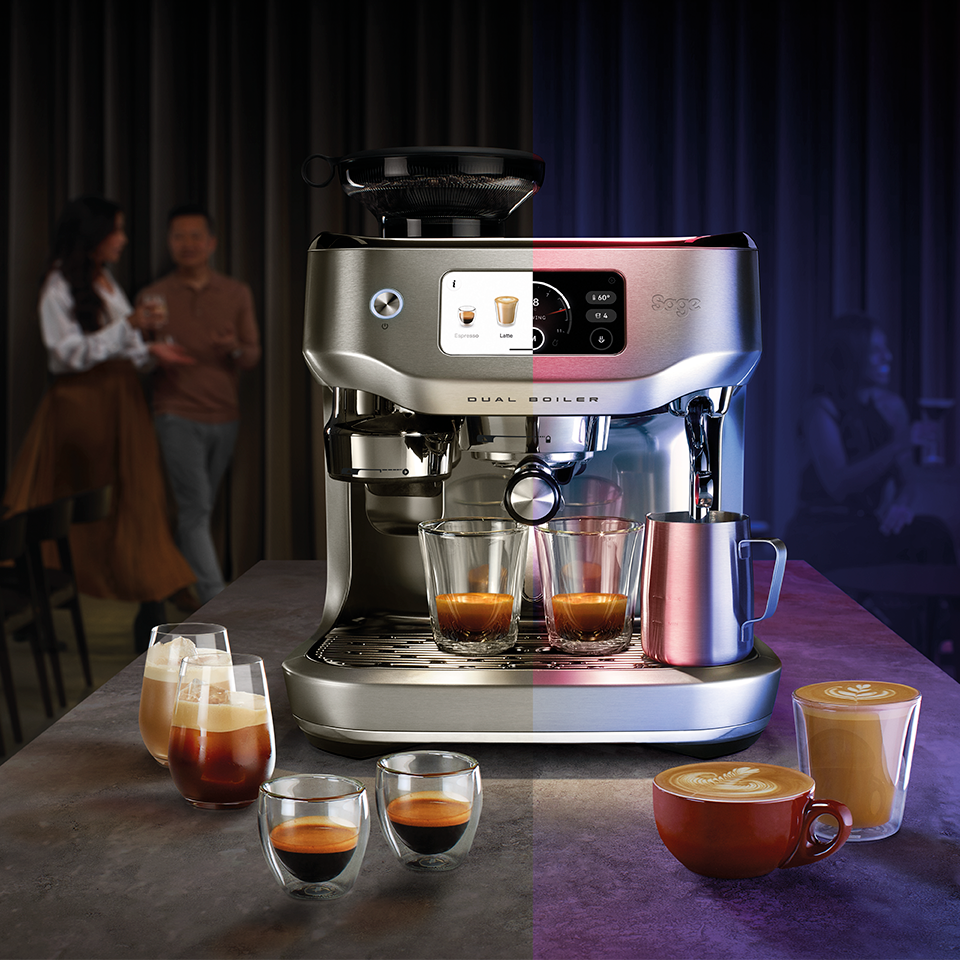
Credit: www.sageappliances.com
Frequently Asked Questions
How Do You Make Cappuccino With An Espresso Machine?
Start by pulling a fresh espresso shot into your cup. Steam and froth milk using the steam wand until creamy. Pour steamed milk slowly over espresso, holding the cup at an angle. Finish with a layer of milk foam on top.
Serve immediately and enjoy your cappuccino.
Do You Put Milk Or Espresso In Cappuccino First?
Pour espresso first into the cup, then add steamed milk and foam. This preserves espresso’s flavor and creates smooth texture.
What Is The Ratio Of Coffee To Milk In A Cappuccino?
The cappuccino ratio is typically 1 part espresso, 1 part steamed milk, and 1 part milk foam. This creates a balanced, creamy drink.
Does A Cappuccino Have 1 Or 2 Shots Of Espresso?
A classic cappuccino usually contains one shot of espresso. Some prefer two shots for a stronger taste.
Conclusion
Making a cappuccino with an espresso machine is simple and fun. Start with fresh coffee beans and clean equipment. Follow each step carefully for best results. Froth the milk until it’s creamy and smooth. Pour slowly over the espresso to keep the layers.
Practice helps improve your technique and taste. Enjoy your homemade cappuccino anytime you want. Small efforts bring big coffee smiles. Give it a try and savor your perfect cup.

